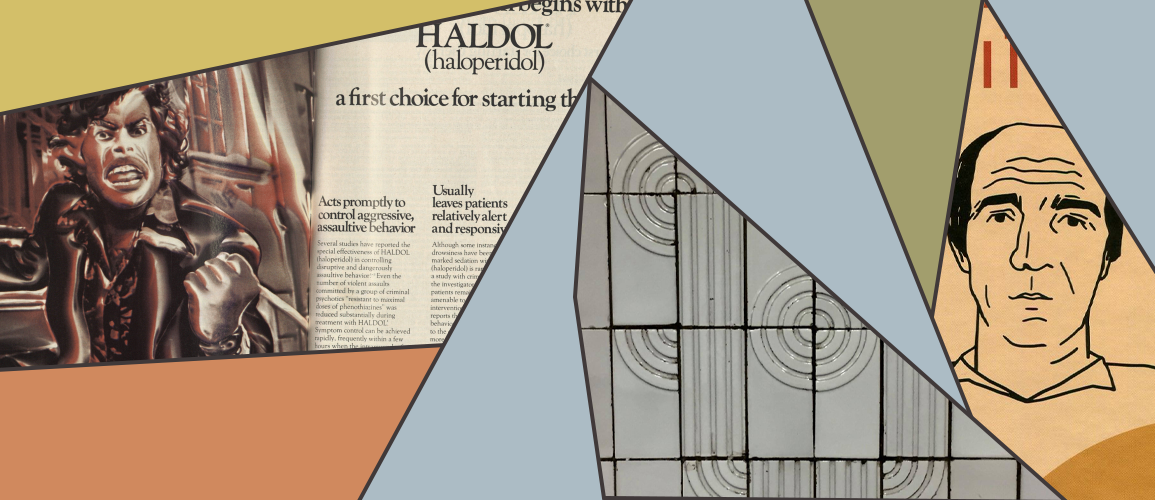Punitive medicine
Discipline and Punish: the practice of punitive psychiatry against dissidents
The practice of isolating people or groups unacceptable to society is ancient. In the Russian Empire, there were prohibitions against the Jewish community residing in cities. At the turn of the 19th to the 20th century, women diagnosed with “hysteria” were made to get treatment. Homosexuality was illegal for a long time; to this day, some LGBT people are still forced into conversion therapy. The essence of all these actions is the same — rejection and attempts to enforce social norms. In the Soviet Union during the 1960s-80s, one such unacceptable group of people were dissidents. They were not allowed to engage in intellectual work or to publish; they were arrested, imprisoned, sent to camps, and subjected to the methods of so-called repressive or punitive psychiatry.
The History of Punitive Psychiatry
Punitive psychiatry, a phenomenon of the 1960s-80s, was a form of fighting against dissidents and political opponents by sending them to psychiatric institutions and subjecting them to strong treatments that damaged physical and mental health. To avoid publicity, anyone could be labeled a schizophrenic and locked up in a psychiatric institution. This made it possible not only to get rid of the person but also to discredit their activities and undermine trust in their judgment.
The Serbsky Center in Moscow was the key psychiatric institution in the USSR. Its director, Georgi Morozov, was one of the central figures of the formation of Soviet punitive psychiatry. The fourth department of this institution was subordinated to the KGB and disclosed no details about its activities.
During this time there were regular and specialized psychiatric hospitals. The former were subordinated to the Ministry of Health of the USSR, the latter to the Ministry of Internal Affairs and so to the KGB. Among the notorious psychiatric institutions of this kind, the most famous was the Dnipropetrovs’k Specialized Psychiatric Hospital. Interestingly, specialized psychiatric hospitals were located near or on the territory of prisons. Dnipropetrovs’k Psychiatric Hospital was next to a prison, with both institutions located behind a stone wall with electric barbed wire. As Leonid Plyushch, dissident and victim of punitive psychiatry, recalled, there were towers with machine guns on the corners of the facility, and doctors, wardens, and criminal orderlies guarded the patients in the ward.
Among those imprisoned in the psychiatric hospitals were writers and social activists Leonid Plyushch, Mykola Plakhotniuk, Vasyl Ruban, Mykhailo Yakubivsky, Vasyl Siryi, Hanna Mykhailenko, Borys Kovgar, and others. The most famous prisoner of the hospitals was Leonid Plyushch, who left us detailed memories of his stay there, and whose story of being arrested and kept in the psych ward we find in the memoir “History’s Carnival: A Dissident’s Autobiography”.

In 1951, Soviet psychiatrists decided not to allow Western science to influence Soviet psychiatry. And the whole of psychiatry was based on the teachings of the neurologist Ivan Pavlov. Those who opposed his methods were abruptly dismissed and placed in less responsible positions. Scholar Andrei Snieznevsky gained a de facto monopoly in Soviet psychiatry. He became the chief advisor to the Minister of Health on psychiatry, director of the Institute of Psychiatry, and editor-in-chief of the only Soviet journal on psychiatry.
Diagnoses in Punitive Psychiatry
The main diagnosis of dissidents was sluggish schizophrenia (or slow progressive schizophrenia), which allegedly was a lighter form of regular schizophrenia and, unlike other types of diseases, didn’t progress. Since there was no particular manifestation of symptoms, doctors were able to manipulate this diagnosis. In general, in the second half of the 20th century, a diagnosis of schizophrenia meant depriving a person of a means of defense in court, because such citizens could be tried without their presence. This was a convenient way to get rid of those who didn’t suit the system. This also applied to the return to society. After a psych ward and sluggish schizophreniadiagnosis, the person received the status of a person with a disability with the note “unable to work and incapacitated”.
If we take a look at the list of diagnoses given to dissidents, they surprise by their disconnect with any real medical classification of illnesses: examples include acute psychosis on the basis of nationalism, reformist delusions, reformist paranoia, uncritical attitude to one’s own abnormal state, inflated self-esteem, poor adaptation to the social environment, revisionism of Marxism-Leninism, schizo-individualism, and pathological individualism.
The Names of Medicines That Make Us Very Calm
Ukrainian poetry of the 1970s-80s is often referred to as “metaphorical”, but its metaphors were actually based on real and horrifying things. In Hrytsko Chubai’s poem “To Speak, to Be Silent, and to Speak Again” there are lines about “the names of medicines that make us very calm.” What might sound beautiful in poetry was terrible in practice.
Which substances were used for “treatment” in specialized psychiatric institutions?
Haloperidol. This is a synthetic antipsychotic medication. It caused akathisia, a feeling of anxiety in the body, which provoked the need to constantly move to relieve tension. Patients feared this medication, so doctors could intimidate and manipulate with haloperidol. Haloperidol is often mentioned in Plyushch’s “History’s Carnival”: he described how his body would swell up, he was apathetic and sluggish, he barely spoke, and he had a very high fever. Another antipsychotic medication spoken about by the author is trifluoperazine.
Sulfur. Sulfur isn’t one of the substances that are dangerous in themselves, but Plyushch often mentions injections of sulfur given to patients as punishment. After the injection, body temperature rises to 40 degrees, the place of the injection hurts, and the person can’t walk or lie down. These injections also caused haemorrhoids.
Insulin. Insulin was prescribed in facilities of punitive psychiatry as shock therapy and could cause a coma.
Punitive "medicine"

Usage
to bring to a state of indifference, for the purpose of intimidation
Effect
Akathisia, feeling of restlessness in the body, swelling, apathy and lethargy, fever.

What was it used for
for punishment
Effect
Fever up to 40 degrees, pain, limitation of mobility, haemorrhoids

What is it used for
shock therapy
Effect
Could lead to coma



Usage
to bring to a state of indifference, for the purpose of intimidation
Effect
Akathisia, feeling of restlessness in the body, swelling, apathy and lethargy, fever.
What was it used for
for punishment
Effect
Fever up to 40 degrees, pain, limitation of mobility, haemorrhoids
What is it used for
shock therapy
Effect
Could lead to coma
Describing his own condition after taking the medication, Plyushch recalls that it made him indifferent to everything except thoughts of smoking and bribing the nurses to let him go to the toilet an extra time. Intellectual work and infrequent visits of his family did not evoke any emotions. The treatment rapidly undermined Plyushch’s health.
Everyday Life in Psychiatric Hospitals
Plyushch tried to prepare himself for potential stays in camps or psychiatric hospitals. With his own interest in professional psychology, he looked for a positive in the opportunity to observe deviances in their purest form. In his memoirs, he writes of developing a poor idea of how psych wards worked from within. Under the influence of neuroleptics, his own reactions, as well as those of other people, were blurred. So, any intellectual life quickly came to naught.
The first thing Plyushch faced was a mismatch between the number of beds and the number of patients. There were so many patients that two beds in the quarantine ward had to be moved together to place Plyushch. Trips to the toilet took place at a certain time and in a strict line, and there was always a struggle for space in the restrooms. Nervous patients pushed each other, and sometimes fights broke out. There were six trips to the restroom per day, and smoking was allowed during three of them.
Plyushch wrote that many psych ward “patients” were criminals who faked illness in order to rest and feed themselves here. retenders were identified by the large doses they were given. Other criminals became nurses, choosing to care for patients rather than work in the camps.
Plyushch describes systematic instances of raping patients and subjecting them to psychological violence such as imitating rape for laughter or threatening to hurt their loved ones. There were also cases of suicide attempts because of fear of the medication. Nurses could beat patients for “bad behavior.” If a patient in the psych ward had a conflict with doctors or nurses, his life was hellish. In such a case, he was immediately prescribed large doses of medication. Life in the hospital was also accompanied by shame: patients wore torn pants and shirts, and the pants did not stay on their bodies because they had no buttons or ties.
Fear
In the 1970s poem by Hrytsko Chubai “To Speak, to Be Silent, and to Speak Again,” a psychiatric hospital is mentioned as a horrendous place where
the names of medicines
that will help us tonight
death cries to the moon
listened to sensibly
will help us see even poetry
in the way one will writhe in pain
Chubai had no experience of being in a punitive psychiatric institution, but he was obviously familiar with the fear of being placed in them. The Soviet system used this phenomenon as a mechanism of fear. Can the distrust of a large number of Ukrainians in psychiatry be a product of this infamous phenomenon of the last decades of the Soviet Union?
Simulating Insanity
Paradoxically, decades before the appearance of punitive psychiatry, Ukrainian artists used psych wards as hiding places from repression and death sentences.
Writer and Ukrainian People’s Army officer Yuriy Gorlis-Gorsky described his experience of staying in a mental hospital in his text “Twelve of them came”. Faking an illness, the author pretended to be afraid of being poisoned, and so he sometimes went on a hunger strike. In this short text, he describes being fed with a tube and restraining himself to not actually grab a piece of bread and eat it.
Another story of simulating insanity concerns Todos Osmachka. We don’t know what happened to this writer, but his friends claimed that he really had persecution mania and therefore trusted people very little. Osmachka’s oeuvre includes a work called “Mental relief,” in which the hero is sent to a psych ward, just as it would happen in the 60s and 80s, because he does not fit into the Soviet system.
Among the famous writers who ended up in the psychiatric hospital was Volodymyr Sosiura, who left us a memory of this episode in “The Third Company”. We should also mention Mykola Kulish’s “People’s Malachi,” whose protagonist was “ placed in a psych ward at Saburova Dacha in Kharkiv. This work from 1927 already contains disturbing notes and hints about not saying everything you think because someone nearby, as one of the patients in the hospital said, is listening carefully.
In general, psychiatric institutions in literature reflected the unhealthy atmosphere in society in both the first and second halves of the 20th century. Saying what you think, dreaming, and being different in the USSR were all considered madness. And this madness was punished, or rather “treated”, with large doses of medication. In the Soviet Union, there was no room for differences. They had to be re-educated, remade, and “cured” to an acceptable norm.
Author: Tetiana Petrenko
Translation: Olena Pankevych
Copy editing: Joy Tataryn
This article is a part of the special project ‘Erasure of a Word’ created in support of the exhibition ‘Antitext’. The project is implemented by the Chytomo media in cooperation with the Kharkiv Literary Museum.


